KISSAKI
Types of Kissaki form, and the period that each form are typical
Kissaki in the shinogi-zukuri style
"KO-KISSAKI"

It is not a matter of shape. It means "small kissaki"
and it is a matter of size.
Most of the time, this word is used for tachi blades in 12th century. For
example, a long blade (about 80 cm) with a wide base (about 30 mm), and
the width becomes narrow toward the kissaki, (about 15 mm at kissaki).
In such blades, the kissaki looks very small comparing to the base. It
is especially called "ko-kissaki".
Such blades have to have big fumbari and an emphatic koshi-sori. The shape of this kissaki is almost the same
as the chu-kissaki or ikubi-kissaki.
This type of kissaki also includes a question of worn out. (=> Changing of blade
shape by Wearing)
"CHU-KISSAKI"
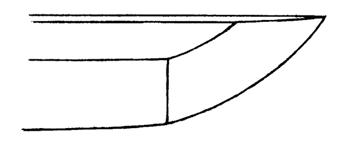
It is the meaning of shape. "chu" means "middle".
The width and the length of the kissaki are in good proportion. The length
looks a little bigger than the width.
It is common on katana blades.
"O-KISSAKI"
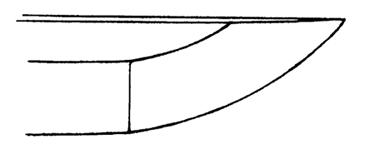
It is a long kissaki. "O" means "large".
The kissaki length is far larger than the width. It looks emphatic for
eyes.
This type started in 14th century. It appears on large blades, over 90
cm long. The blade width also is large towards the kissaki and it is proportional
to the length. But the thickness doesn't become so large.
A wavy hamon pattern (notare) were developed at the same age as a set with
long kissaki.
"IKUBI-KISSAKI"
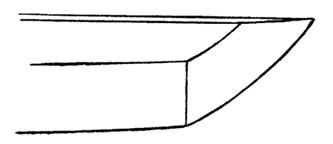
It is a short kissaki.
The kissaki width and the length are almost same. It looks robust and steady.
It is a typical shape of tachi blades in 13th century.It appears on broad
and thick blades in that period.
How to distinguish the kissaki type?
As a matter of fact, it is difficult to distinguish the kissaki types on
actual blades, with Ikubi-, Chu-, and O-kissaki. It is settled just by
an optical impression. So sometimes, each person sees each kissaki in different
types. So there is no exact rule to distinguish them by measurements.
If we try to find a way to distinguish them,
Ikubi-kissaki (short kissaki), kissaki length is shorter than yokote width
x 1.5
Chu-kissaki (medium kissaki), kissaki length is in the range yokote width
x 1.5 ~2
O-kissaki (long kissaki), kissaki length is longer than yokote width x
2
"KAMASU-KISSAKI"
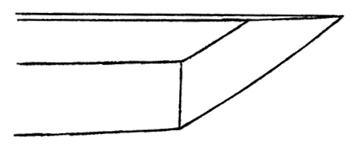
The line from the start of the kissaki to the top of
it is almost straight.
Such a kissaki is especially called "kamasu-" even if the kissaki
is long or short. It looks very sharp.
This type has a little different meaning than other types. Because, this
type is an original shape of the kissaki before 14th century. But it is
very rare to be found today.
The tip is very sharp and delicate, so it is easy to be broken in a fight.
The kissaki line easily becomes round by re-polishing after use. We can
see kamasu type only on healthy blades in some old temples or shrines as
their treasure. They were put in there before use to celebrate Buddha or
god.
=> Uesugi tachi of Ichimonji 
Therefore we have to change the image of the kissaki
shape when we think about the original in the period of samurai living
before 14th century.
After 15th century, most of the kissaki shape is "chu-" and "o-kissaki",
never seen "ikubi-" or "ko-kissaki".
"Regarding blade form and samurai culture in the history"
Some type of kissaki is typical in a particular period of time. Of course
it comes from practical advantages in the fighting style, but that is not
the only reason. The spirit of the samurai culture makes the styles of
each period.
Of course, there are various types of blades in every period. We speak about just the typical type of each period.
The late Heian to the early Kamakura period
In the 12th century, the samurai's' status is not so high. They are guards
of the nobility. The government never stand without samurai, but they don't
have political power. They fight often for the political game of nobilities.
And they are longing for the nobility culture.
In the battle field, the main weapon is the bow and arrow, so the armour
is heavy and hard. The typical blade style in this period is big fumbari, emphatic koshi-sori, and ko-kissaki. It is elegant for the eyes and good
to aim for the openings in the armour.
It is told that such an elegant form suggest the samurai's yearning for
the nobility culture. But, most of the blades from that period is very
worn. we have to study again if the form is so in its original. (=>
Changing of blade shape by wearing)
The early Kamakura period to the middle
At the end of 12th century, samurai get their own government. Officially,
it is a guard of the emperor.
Blades become strong and powerful. In other words, thicker and wider.
The late Kamakura period
In the late 13th century, Japan gets attacked by Mongolia twice. Samurai
fight very hard and then they have to prepare for the third attack. The
period is very exciting and samurai's are united against the next invasion.
In this period the blade with an ikubi-kissaki is typical. The strong blade
with ikubi-kissaki is a symbol of the samurai spirit in this age. A short
and thick kissaki may be heavy duty.
The Nambokucho period
In the early 14th century, the samurai government is broken and two imperial
governments appear. Samurai's fight each other for their emperors. There
is no order in samurai society. Each samurai tries to display themselves
to emphasize their power.
In this period, large and O-kissaki blades become typical. So also is an
artificial wavy hamon and designed engravings. Such a blade is easy for
the eyes to feel the power.
The Muromachi, Momoyama, and Edo period
After 15th century, most of the blades have chu-kissaki or o-kissaki. There
is no era that has a special kissaki type.
In history, the style of the blade is a fashion of the period. Probably
it means the spirit of the samurai culture in the period.
FUMBARI
Every blade has a form where the width and the thickness becomes larger
toward the tang. In other words, a blade is tapered from the wide base
toward the narrow head.
Fumbari is a form that has a large rate of taper on the base. It is a very
important point to appreciate the shape of blades.

The word "fumbari" means straddle or standing with power
on the legs.
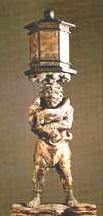 This buddha
is "fumbari-ing". (a statue in Kamakura period)
This buddha
is "fumbari-ing". (a statue in Kamakura period)
Fumbari is very effective to make blades look steady and strong. Shortened
blades have no fumbari even if it has large width at the base.
For example, tachi blades in the Kamakura period (12-13c.) have a big fumbari,
so when they are shortened, the fumbari disappears and the shape looks
strange with its weak looking base. Such blades still have a large width
at the base but the rate of the width becoming larger toward the tang is
average.
An example of an original length tachi blade.

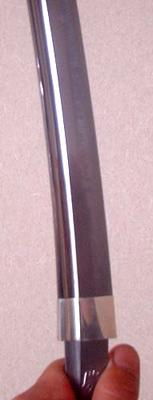
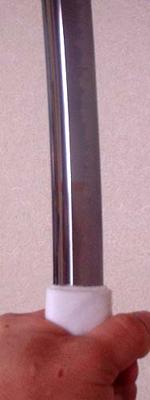
The left shows the fumbari of the original length blade.
The right is the same blade holding at a 10 cm shortened position.
It is difficult to explain the difference of feeling because it is an optical
effect, but very large. You should feel it by handling a real blade.
An example of O-suriage katana blade.
It was born as long tachi blade in 14th century, then
it was shortened to the length that has no original tang.

It has no fumbari, even though it still has enough width.
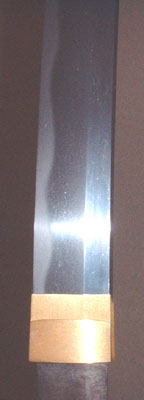
A large width at the base and narrow head doesn't mean
it is a fumbari. Such form is just a "wide base and narrow head" or "large
tapered".
Fumbari is not a matter of width, but it is a matter of the rate of taper.
Fumbari is a conscious width and thickness that becomes larger at the base.
Home > Terms > Kissaki, Fumbari
 This buddha
is "fumbari-ing". (a statue in Kamakura period)
This buddha
is "fumbari-ing". (a statue in Kamakura period)

